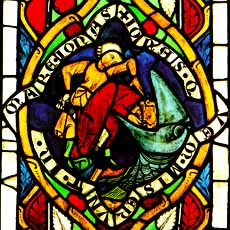
|
Choir
of the City/Parish church St.Dionysus
Jonah from the Steinhövel window, Speyer
1280
The Prophet had to spend three days in a
fishes' belly to atone for his disobedience. Jesus lay in his
grave for the same length of time to expiate the sins of mankind,
therefore the two themes have been combined here. The Jonah scene
has been cleverly fitted into the surrounding Banderoles and Plant
Arabesques. The scene is very dramatic, showing a man forcing the
disobedient prophet into the fishes' maw.
If you click on the windows, you can see the image enlarged with
greater detail. |
Glowing Treasures
The stained glass windows in the City/Parish
church.
The Esslingen church history begins
after the Evangelical City/Parish church with a simple
single-aisled church in the 8th century, which was replaced by
ever larger buildings over the centuries. The various phases are
documented in the Excavation Museum.
The core of the nave which still stands
today was built between 1250-65, and shows obvious influences from
the architecture of the Mendicant Orders. Instead of a vaulted
stone roof, it has a flat wooden ceiling. The two towers flanking
the choir, finished around 1300, and their connecting bridge are
perhaps Esslingen's most well-known landmark. At the beginning of
the 14th century the nave was lengthened and a new choir was
built. Here are the vast majority - 226 panes - and the
oldest of the medieval stained glass windows in Esslingen; a
glowing treasure of many-facetted paintings.
The glass panes were made in two,
perhaps three workshops in 1280, 1300 and 1330. Rich patricians
donated the first set of windows in 1280, but the new High Gothic
choir for which they were made was only started by the Speyer
Cathedral Chapter, who owned the church until the Reformation,
around 1300. In order to accomodate these windows and new ones as
well, five quadripartite windows were inserted, which was unusual
for this period. |